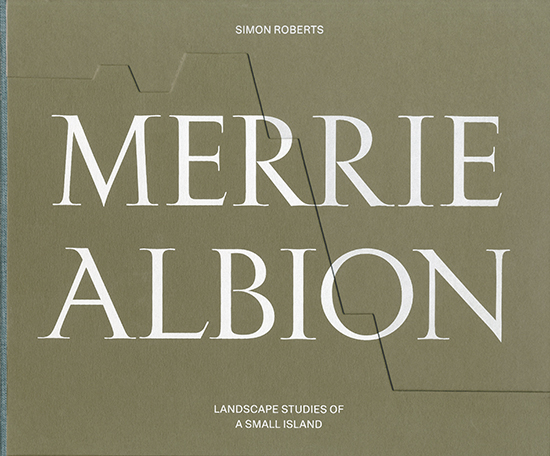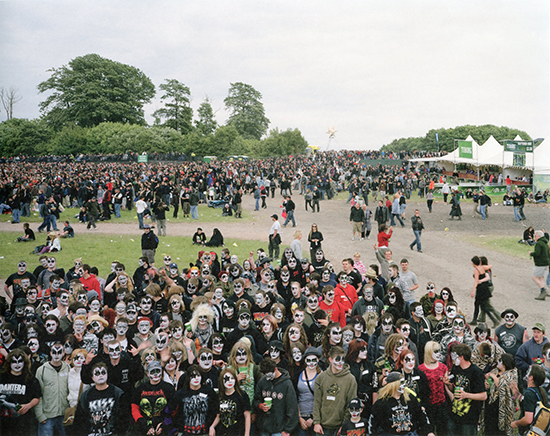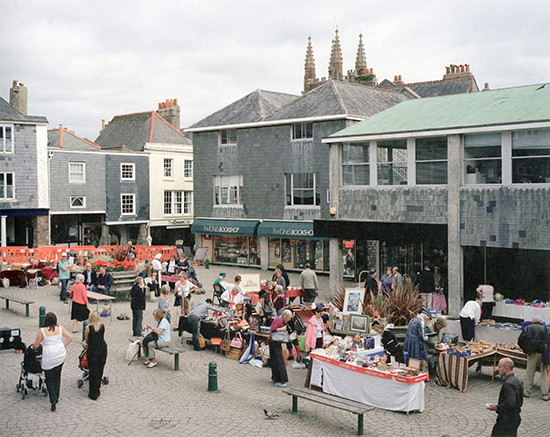| SIMON DENISON IMAGE & TEXT |
| PREVIOUS | NEXT |
MERRIE ALBION Simon Roberts Dewi Lewis, 2017 ISBN 978-1-911306-19-1 Hb
In We English, Simon Roberts’ 2009 book depicting people’s leisure-time relationships with land and place, Roberts emerged as a contemporary master of the ‘long look’ style of social landscape photography. Large format, high camera angle, wide view: it is a style of picture-making that presents a vast array of visual facts and through its god-like gaze encourages searching examination, immersion and reverie. The landscapes of We English, generally dominant over figures in the scene, were depicted with a luminosity and at a scale that often suggested a sublime tranquillity. The English appeared at ease with their environment, the land a setting capable of inducing contentment and wonder. The warm tonality and wide dynamic range of the printing added to the book’s euphoric affect. Merrie Albion takes us into altogether darker terrain, presenting a very different kind of Britain. Its images, made since 2007, have a surface similarity to those in the earlier book – mostly high angle, wide view – but generally the landscapes have closed in, with a greater focus on people, typically in crowds. Some continue to address the theme of the earlier book; but these are interspersed with images of newsworthy events, including the 2010 General Election (for which Roberts was official Election Artist), the 2012 Olympics, the Royal Wedding of William and Kate, numerous austerity-era protests and demonstrations, the Scottish and EU Referendums and aftermath images of the 2011 urban riots and the 2017 Grenfell Tower fire. The book has an air of neutral detachment and comprehensive UK-wide coverage but a subtle rhetoric of selection and framing plays across many of the images and Roberts’ commentaries on them. Brexit is a recurring theme, and although most of the images predate the 2016 referendum, the book is coloured by the dominant metropolitan mood of the hour, presenting a fractured and unfair society, half the population overlooked and angry, remote and insensitive political decision-making, unwarranted fears over immigration, and impending economic disaster. Roberts offers even-handed sympathy for all groups who either are, could be, or may imagine themselves vulnerable and threatened: people leading seemingly marginalised lives, such as the white family sitting on the pavement outside their terraced home in segregated Blackburn; minority community gatherings; a picture of the Vaisakhi Mela Sikh festival placed next to one of a St George’s Day parade. There are numerous pictures of conflict and protest: against student fees, teachers’ pay cuts, the planned privatisation of Royal Mail, local government cuts, fracking, capitalism itself. The engagement of politicians in the democratic process is laid bare for the illusion that it is, as the wide-angle view reveals the careful staging of election events for the TV cameras. Images of flooding in the Somerset Levels, and a view of pastures earmarked as a site for the future HS2 rail line, add notes of environmental threat to the general gloomy texture. The book’s cover design is based on a downward economic graph made to illustrate an aspect of the 2008 financial crash, at the same time visually connoting the cliff-edge Brexit that many fear. The book’s opening and closing images depict period-costumed Dickens fans cavorting in the sea at Broadstairs and visitors peering over the cliffs at Beachy Head: a nation, perhaps, with a nostalgic longing for the past facing abrupt isolation from Europe. Merrie Albion indeed. What kind of people are we, who live in this merry land? The book suggests, above all, that we gather to protest, to take part in social-identity celebrations, to shop and to spectate. Many images depict people looking and watching, experiencing life as commodified spectacle: the Olympics, the Royal Wedding on big screen, air shows, processions, tourist sites, the appearance of a celebrity politician. There is a pervasive shoddiness, fakeness, absurdity, about the events we take part in, and the urban environments in which they take place. An Olympic equestrian event deploys ludicrous jumps in the form of heritage monuments such as Stonehenge and the Houses of Parliament. The Cotswold Olimpicks at Chipping Campden features men racing with buckets of water, the intention to get as wet as possible, in front of a conspicuously flimsy model of Dover Castle in a field. The market square in Totnes, surfaced in the locally-inappropriate grey industrial paviors of pedestrianised zones everywhere, hosts what looks like a crafts market, at which stall-holders unaccountably tend their stalls wearing medieval costumes. A crowd of glam-rock Kiss fans at a festival at Castle Donnington gathers for the camera, made up with ghoulish black-and-white face-paint to mimic the band’s stage identity. Many wear merchandised t-shirts; most also bear a sticky label on their chest: stamped and validated by the authorities as having paid their money to attend the event. Despite the vaguely menacing make-up, some of the youngsters make awkward, friendly gestures at the camera. A few images push against the current, showing what seems more like an authentic activity, a first-hand encounter with the world, something that has not been purchased or handed down as a preconstructed ritual; or something someone has chosen as part of a project for making a better life for themselves and for society. A girl leaps for pleasure into the River Esk. Small groups of walkers support refugees on a story-telling pilgrimage along the North Downs Way. Two men shake hands in the street in an act of warm mutual recognition. A family tends an allotment in Bristol, where vegetables grow strongly out of the dark soil. Such images are outnumbered in this oddly dispiriting book; but I am grateful they are there, as they suggest – in a dim echo of We English – that there could be some hope for us after all. |
 |
|---|---|
 |
|
 |
|